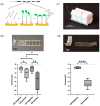Toward Continuous Molecular Testing Using Gold-Coated Threads as Multi-Target Electrochemical Biosensors
- PMID: 37754078
- PMCID: PMC10526339
- DOI: 10.3390/bios13090844
Toward Continuous Molecular Testing Using Gold-Coated Threads as Multi-Target Electrochemical Biosensors
Abstract
Analytical systems based on isothermal nucleic acid amplification tests (NAATs) paired with electroanalytical detection enable cost-effective, sensitive, and specific digital pathogen detection for various in situ applications such as point-of-care medical diagnostics, food safety monitoring, and environmental surveillance. Self-assembled monolayers (SAMs) on gold surfaces are reliable platforms for electroanalytical DNA biosensors. However, the lack of automation and scalability often limits traditional chip-based systems. To address these challenges, we propose a continuous thread-based device that enables multiple electrochemical readings on a functionalized working electrode Au thread with a single connection point. We demonstrate the possibility of rolling the thread on a spool, which enables easy manipulation in a roll-to-roll architecture for high-throughput applications. As a proof of concept, we have demonstrated the detection of recombinase polymerase amplification (RPA) isothermally amplified DNA from the two toxic microalgae species Ostreopsis cf. ovata and Ostreopsis cf. siamensis by performing a sandwich hybridization assay (SHA) with electrochemical readout.
Keywords: chronoamperometry; isothermal DNA amplification; metal-coated threads; roll-to-roll; sandwich hybridization assay; self-assembled monolayers.
Conflict of interest statement
The authors declare no conflict of interest.
Figures



Similar articles
-
Electroanalytical Paper-Based Nucleic Acid Amplification Biosensors with Integrated Thread Electrodes.Anal Chem. 2021 Oct 26;93(42):14187-14195. doi: 10.1021/acs.analchem.1c02900. Epub 2021 Oct 14. Anal Chem. 2021. PMID: 34648274 Free PMC article.
-
Woven Electroanalytical Biosensor for Nucleic Acid Amplification Tests.Adv Healthc Mater. 2021 Jun;10(11):e2100034. doi: 10.1002/adhm.202100034. Epub 2021 Apr 30. Adv Healthc Mater. 2021. PMID: 33930257
-
Portable electroanalytical nucleic acid amplification tests using printed circuit boards and open-source electronics.Analyst. 2022 Sep 26;147(19):4249-4256. doi: 10.1039/d2an00923d. Analyst. 2022. PMID: 35993403 Free PMC article.
-
Biosensors Based on Isothermal DNA Amplification for Bacterial Detection in Food Safety and Environmental Monitoring.Sensors (Basel). 2021 Jan 16;21(2):602. doi: 10.3390/s21020602. Sensors (Basel). 2021. PMID: 33467078 Free PMC article. Review.
-
Rolling Circle Amplification in Integrated Microsystems: An Uncut Gem toward Massively Multiplexed Pathogen Diagnostics and Genotyping.Acc Chem Res. 2021 Nov 2;54(21):3979-3990. doi: 10.1021/acs.accounts.1c00438. Epub 2021 Oct 12. Acc Chem Res. 2021. PMID: 34637281 Free PMC article. Review.
References
-
- Oliveira B.B., Veigas B., Baptista P.V. Isothermal Amplification of Nucleic Acids: The Race for the Next “Gold Standard”. Front. Sens. 2021;2:752600. doi: 10.3389/fsens.2021.752600. - DOI
MeSH terms
Substances
Grants and funding
LinkOut - more resources
Full Text Sources
Research Materials

